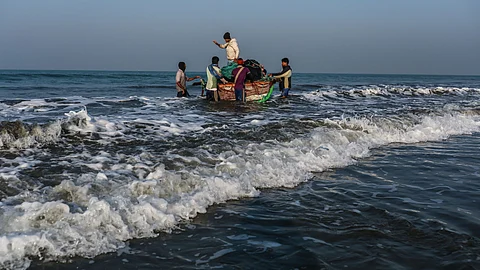
- Home
- About
- Globally Speaking
- Videos
- Podcast
- Geopolitics
- Industry
- SIGN UP

The Modi Cabinet has approved a $540-million programme to study ways of mining nickel, cobalt, manganese and iron hydroxide from the bed of the Indian Ocean 6,000 metres below sea level. These can power India’s growth for 100 years. It will also study climate change, explore marine flora and fauna and harness thermal energy for use on land.
The Narendra Modi government has approved the “Deep Ocean Mission”, which envisages utilising minerals lying at the bottom of the Indian Ocean in a sustainable manner. This mission will also enable India to study ocean bio-diversity, assess the impact of climate change and establish an offshore marine station to harness thermal energy.
“Cabinet approves the proposal of the Ministry of Earth Sciences on 'Deep Ocean Mission' with a view to explore deep ocean for resources and develop deep-sea technologies for sustainable use of ocean resources," a spokesperson for the Government of India said after the Cabinet meeting on Wednesday.
The ocean bed is rich in rare earth minerals like cobalt, nickel, manganese and iron hydroxide, which are critical for manufacturing batteries, solar panels and smartphones. There are 380 million tonnes of such metals in the area allocated to India. Even 10 per cent of this can provide India with enough energy for the next 100 years.
“The mission will notice changes, because of climate change, to study more deep-sea biodiversity. There will be deep sea survey. There will be advanced marine station for ocean biology. And there will also be offshore ocean station (to explore) thermal energy as part of the mission," Indian Minister for Environment, Forests and Climate Change Prakash Javadekar said.
The ocean bed is rich in rare earth minerals like cobalt, nickel, manganese and iron hydroxide, which are critical for manufacturing of batteries, solar panels, smartphones and other electronic devices. At present, China has a near monopoly on the mining and extraction of most such minerals.
India has a coastline of 7,500 km and 1,382 islands scattered across the Indian Ocean, Bay of Bengal and the Arabian Sea. This gives it an exclusive economic zone (EEZ) of 2.2 million square kilometres, which is almost completely unutilised.
The International Seabed Authority has allocated 75,000 square kilometres in the Central Indian Ocean Basin to India for the exploration of polymetallic nodules from the seabed.
These nodules are small potato-shaped formations composed of the above metals and lie scattered on the bed of the Indian Ocean at depths of 6,000 m. It is estimated that there are 380 million tonnes of polymetallic nodules in the area allocated to India.
These contain 4.7 million tonnes of nickel, 4.29 million tonnes of copper, 0.55 million tonnes of cobalt and 92.59 million tonnes of manganese. Even 10 per cent of these minerals could provide India with enough energy to last the next 100 years.
The mission involves developing a submersible capable of carrying three persons to a depth of 6,000 km with the necessary high technology tools and sensors. It also envisages developing an integrated mining system for mining nodules at that depth.
“The exploration studies of minerals will pave the way for commercial exploration in the near future, as and when Commercial Exploitation Code is evolved by the International Seabed Authority, a United National organisation,” says a government press release.
If successful, India will become the sixth country after the US, Russia, France, Japan and China to have this technology.
‘The exploration studies of minerals will pave the way for commercial exploration in the near future, as and when Commercial Exploitation Code is evolved by the International Seabed Authority, a United National organisation,’ says a government press release.
The Mission also aims to develop Ocean Climate Change Advisory Services to enable scientists to make projections about climate change in the coming years and decades. Then, the Mission will also search for deep sea flora and fauna and research on ways to use them in a sustainable manner.
Further, it will identify sources of hydrothermal minerals that are sources of precious metals. The fifth goal of the mission will be to study and prepare a detailed engineering design for offshore Ocean Thermal Energy Conversion (OTEC)-powered desalination plants.
And finally, the project aims at creating a pool of experts and scientists in the field of ocean biology and engineering with the ultimate goal of developing industrial applications and products using on-site business incubator models. “Attempts will be made to indigenise technologies by collaborating with leading institutes and private industries,” read the official statement about the Mission.
The cost of the Mission has been pegged at $540 million over five years. An initial outlay of $380 million has been planned for the 2021-24 period. The Ministry of Earth Sciences will be the nodal ministry, a government statement said, adding that experts from the Indian Space Research Organisation (ISRO), Defence Development and Research Organisation (DRDO), Department of Atomic Energy, Council of Scientific and Industrial Research (CSIR), Department of Biotechnology and the Indian Navy will also be involved in this project.
If the mission is successful, India will become the sixth country in the world after the US, Russia, France, Japan and China to have this technology.
There is a strategic angle to this mission as well. Given the centrality of the Indian Ocean to global trade and efforts by outside powers to establish a foothold in the region, the mission will help India secure its economic and geo-political interests in South Asia.